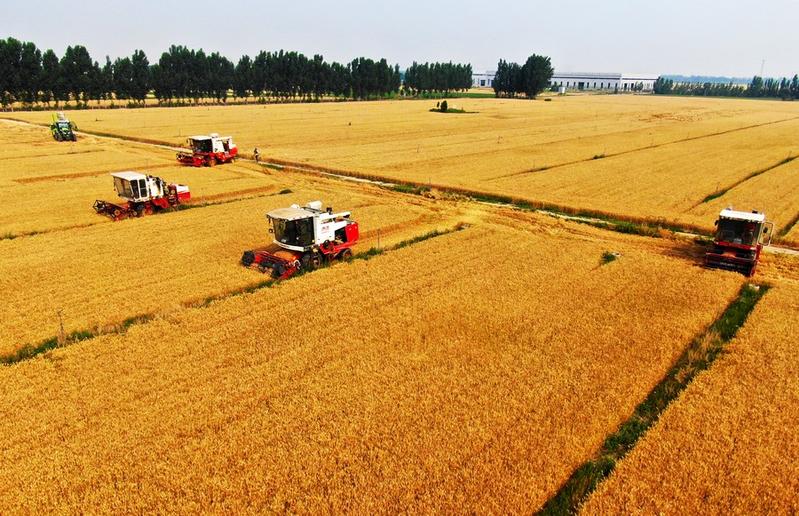


Chinese scientists have bred a number of new varieties of major crops during the 13th Five-Year Plan period (2016-2020), providing solid support for the country's food security, the Chinese Academy of Agricultural Sciences (CAAS) said Tuesday.

Aerial photo taken on June 12, 2020 shows farmers operating harvesters in wheat fields in Dafu Village, Botou City of north China's Hebei Province. (Xinhua/Mu Yu)
The CAAS has made remarkable scientific and technological progress in staple crop breeding in recent years.
A series of significant achievements have been made in genome analysis, cloning of new genes and key breeding technologies for crops including wheat, rice, corn, soybean and coarse cereals, Wan Jianmin, vice president of the CAAS and also an academician of the Chinese Academy of Engineering, said at a press conference.
The research results have been published in top international journals such as Science, Nature, Nature Biotechnology and Nature Genetics, providing the theoretical basis and technical support for genetic improvement and precise breeding, Wan said.
According to him, the CAAS has made breakthroughs in breeding new crop varieties of staple crops that are of high quality, more tolerant for tough conditions and more suitable for machine reaping.
He also mentioned that a research center for protecting and utilizing crop germplasm resources has been set up, preserving the second-largest amount of crop germplasm resources in the world.
With science and technology making more contribution to agriculture, China saw solid progress in modernizing its seed industry.
The coverage rate of improved crop varieties in the country has exceeded 96 percent, Wan said.
China's independently cultivated varieties occupy more than 95 percent of the total crop planting area, he said, adding that China is completely self-sufficient in the production of rice and wheat, two staple grains of the country.
China's total grain output reached 669 million tonnes in 2020, exceeding 650 million tonnes for the fifth consecutive year. Its per capita grain supply has reached 478 kilograms, higher than the world average of 400 kilograms.
The CAAS said it has unveiled a series of programs to boost the development of seed industry with the help of science and technology in the 14th Five-Year Plan period (2021-2025).
It will promote the third national survey and collection of crop germplasm resources, and speed up the building of a modern, automated and intelligent national crop seed bank.
It also plans to enhance basic research on biotechnological breeding, according to Wan.
He also said that the CAAS plans to accelerate the cultivation of new crop varieties that are environment-friendly, resource-efficient, high-quality, and suitable for simple cultivation and mechanized production for major grain-producing areas in China.
The CAAS will focus on developing new varieties such as green super rice, water-saving wheat, scab-resistant wheat, drought-tolerant corn, and high-yield and high-protein soybean, providing scientific and technological support for improving the quality and efficiency of the country's agriculture, said Wan.
